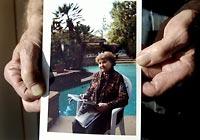"Sweet lady" surprise: Nazi prison-guard past

WASHINGTON — Elfriede Rinkel lived alone in a tiny, top-floor apartment in one of the tougher sections of San Francisco. At 84, she was short and a bit stout. Diabetes took the sight in one eye; arthritis left her leaning heavily on a cane.
Her husband, Fred, died. He was the love of her life, a short, dapper man who had worked as a bartender and waiter at some of the city's larger hotels and was active in Jewish activities. He was buried in a Jewish cemetery outside the city.
He had been gone just a short while when two officials from the Justice Department in Washington knocked on her door. They confronted her with a terrible secret that she had managed to keep from Fred all these years.
In Germany during World War II, before she married, Rinkel had worked as a guard at Ravensbrück, a Nazi concentration camp. During the year she worked at the slave-labor prison for women, more than 10,000 women died.
Some succumbed to starvation and disease. Others were gassed. More died after cruel medical experiments. Some died from sheer exhaustion.
On Tuesday, the Justice Department announced that the woman with the pleasant smile and the German accent had been deported to Germany. She admitted she had lied on her U.S. visa application.
Her lawyer, Allison Dixon, said Rinkel never told her husband. Always, she kept quiet.
"He did not know," the lawyer said, "because all these years she was totally embarrassed."
Washington officials, however, said she offered no expression of remorse about her past and did not fight deportation.
"An affront" to survivors
The government caught up with a woman who expected, perhaps, soon to join her husband in the Eternal Home Cemetery in Colma, south of San Francisco. The double gravestone was there, with the Star of David above their names.
Instead, Rinkel will be remembered as the only woman to be caught and deported in more than 100 completed cases of Nazi persecutors who lied their way into the United States.
Matching Ravensbrück guard rosters with U.S. immigration documents — about 70,000 names have been studied since the Office of Special Investigations (OSI) opened in 1979 — they lit on Elfriede Huth, her maiden name.
She had been born in 1922 in Leipzig, Germany. She went to Ravensbrück in 1944 and left a year later as the war ended, the site abandoned by fleeing Nazis. She married Fred William Rinkel, a German Jewish refugee from the war. In 1959, she applied for a U.S. visa but failed to include on the form her time at Ravensbrück.
Eventually, the Justice Department traced her to the five-story apartment building in lower Nob Hill near the Tenderloin.
Despite Rinkel's age, "her presence in the United States nevertheless was an affront to surviving Holocaust victims who have made new homes in this country," said OSI Director Eli Rosenbaum.
According to Rosenbaum, Rinkel said she volunteered to be a dog handler at the camp because it paid better than her factory job.
But she insisted she never used her dog as a weapon against the prisoners and claimed she never joined the Nazi Party. And she said she never applied for U.S. citizenship because she feared U.S. immigration authorities would learn of her time at Ravensbrück.
"Trying to atone"?
Dixon, her San Francisco lawyer, said her client had tried to remake her life and never thought she would be tripped up so late in her years.
"She was trying to atone for actions in the past," Dixon said. "She married a Jewish man, and she gave to Jewish charities.
"And she always believed there was a certain coercion involved in what she did at the camp. She insisted that she had zero contact with the actual prisoners, that she just walked the camp perimeter."
Knowing her fate, six months ago Rinkel quietly set about putting her affairs in order.
One task was to return once more to the mortuary, and to inform the staff that she would soon be "leaving the area." She wanted to sell back her burial plot next to her husband.
"So we took it back," said Gene Kaufman, director of the Sinai Memorial Chapel. "She was just such a pleasant-looking lady and very small. Such a nice sweet lady who seemed to have a very loving relationship with her husband."
Sometimes, Kaufman said, he would bump into the childless couple at Jewish events. Everyone seemed to know, though, that she was not Jewish, and had no other religious faith. The distinction never seemed to rise as a problem between the couple.
Yet, "sometimes it did seem like their life together was from someplace else," said Kathryn Allen-Katz, who also chatted with her at the funeral chapel. "They lived in their own little island in a not-too-good part of town and they kept to themselves."
At the apartment building on Bush Street, Gunvant Shah, who met the Rinkels in 1976, described a couple that sang German songs late at night, danced together, and sometimes fought loudly, prompting complaints from neighbors.
They lived "a modest life," Shah said, with no car, but often strolled together in the evenings, dressed elegantly. "Mr. Rinkel would hold her by the arm. They would walk together, proud and joyful."
She was given until Sept. 30 to leave the United States. She left Sept. 1. Some distant relations took her in, and she reported to the U.S. Consulate office in Frankfurt, Germany, that she was back home.